Imagine the world of trading as a vast ocean, and Exponential Moving Averages (EMAs) as your compass guiding you through the turbulent waters of market trends.
As you navigate through the 10 best explanations of EMAs, you'll uncover valuable insights that can sharpen your decision-making skills and enhance your trading strategies.
Each explanation delves into a different aspect of EMAs, offering a comprehensive view of their significance and practical applications in the realm of technical analysis.
Explore these insights to elevate your understanding and make informed trading choices based on solid foundations.
EMA Definition and Importance
Exponential Moving Average (EMA) stands out as a dynamic indicator in technical analysis due to its emphasis on recent price data. The EMA gives more weight to recent prices, making it highly responsive to current market conditions. This feature makes EMA particularly useful for traders looking to analyze trends swiftly and make informed decisions on entry and exit points in trading.
Compared to Simple Moving Average (SMA), EMA reacts more quickly to price changes, enabling traders to capture potential opportunities promptly. By using EMA crossovers, traders can identify possible buy or sell signals with greater efficiency. EMA also helps smooth out price fluctuations, providing traders with dynamic support and resistance levels for better risk management in their trading activities.
EMA Calculation Explained Simply
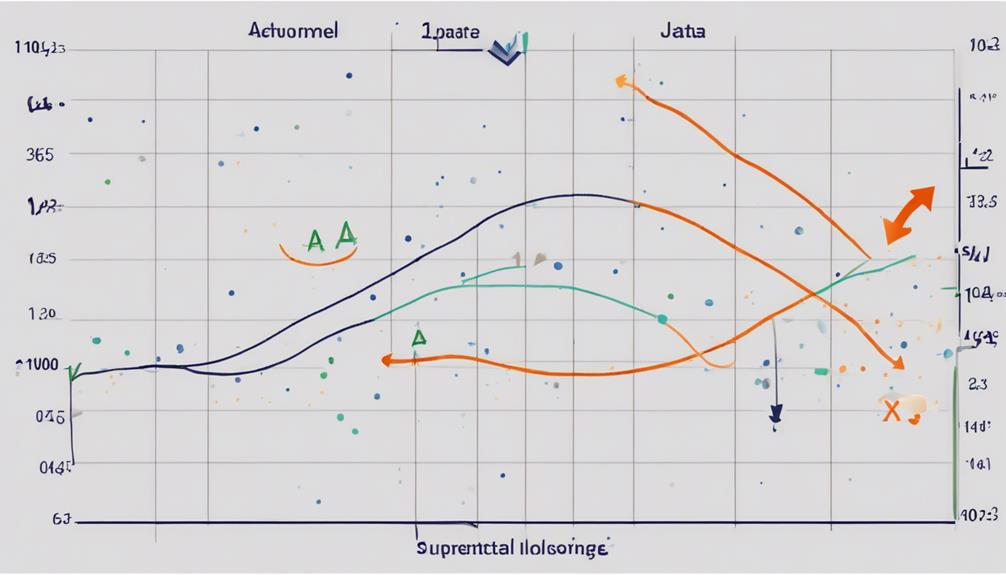
To calculate the Exponential Moving Average (EMA) simply, a smoothing factor is applied to prioritize recent data points in the formula. The EMA formula incorporates the current price, prior EMA values, and a weighting multiplier.
This weighting multiplier is calculated using 2 / (number of periods + 1). By giving more weight to recent data points, EMA can react quickly to price changes and identify trend direction efficiently.
Traders prefer EMA over other moving averages for its responsiveness in capturing current market movements. EMA's method of utilizing prior EMA values in its calculation ensures a more dynamic trend indicator, making it a favored tool for those looking to navigate the market effectively.
EMA Vs. SMA: Key Differences
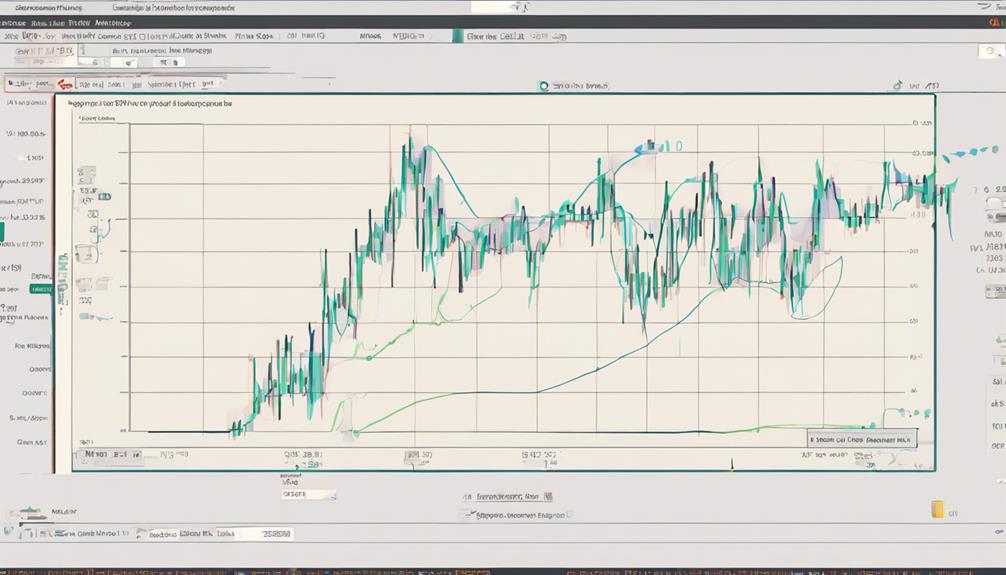
When comparing EMA and SMA, one notable distinction lies in their approach to weighting data points. EMA gives more weight to recent data, making it sensitive to price changes, favored by short-term traders.
In contrast, SMA treats all data equally over a specified period, providing a steadier trend line, commonly used by long-term investors. EMA reacts faster to price movements due to its emphasis on recent prices and is more suitable for intraday trading, offering high sensitivity to market fluctuations.
On the other hand, SMA offers a simple average of prices, ideal for identifying longer-term trends. Traders often use EMA crossovers for buy and sell signals, indicating potential trend shifts, while SMA provides a stable trend line over time.
Practical Use Cases of EMA
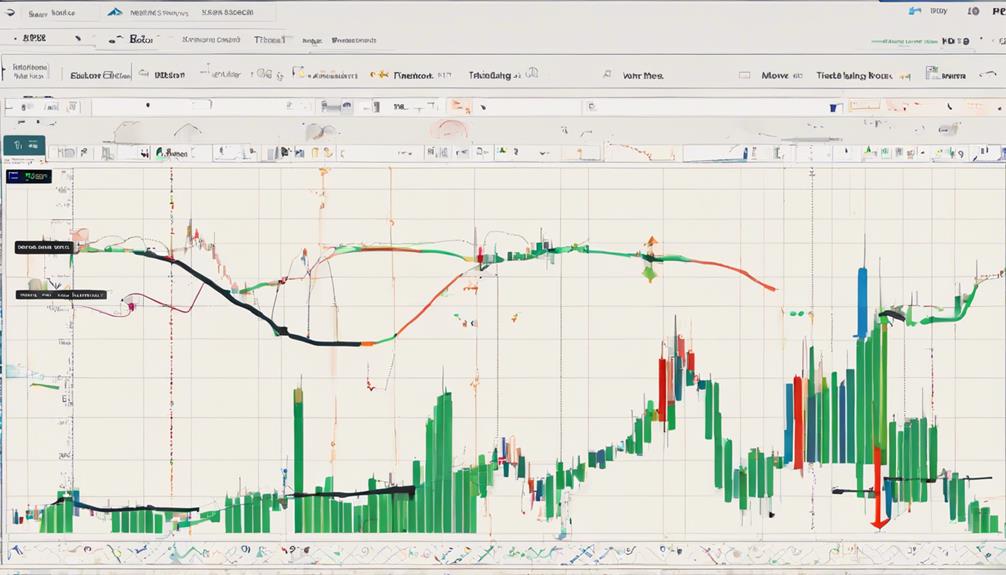
Traders frequently utilize Exponential Moving Averages (EMA) to pinpoint trend direction and potential entry/exit points in the market. When considering practical use cases of EMA, here are key points to remember:
- EMA helps identify dynamic support and resistance levels, aiding in strategic decision-making.
- EMA crossovers, such as short-term EMA crossing above/below long-term EMA, provide crucial signals for entry and exit points.
- Utilizing different EMA periods allows traders to adapt strategies to various timeframes efficiently.
EMA Limitations and Considerations
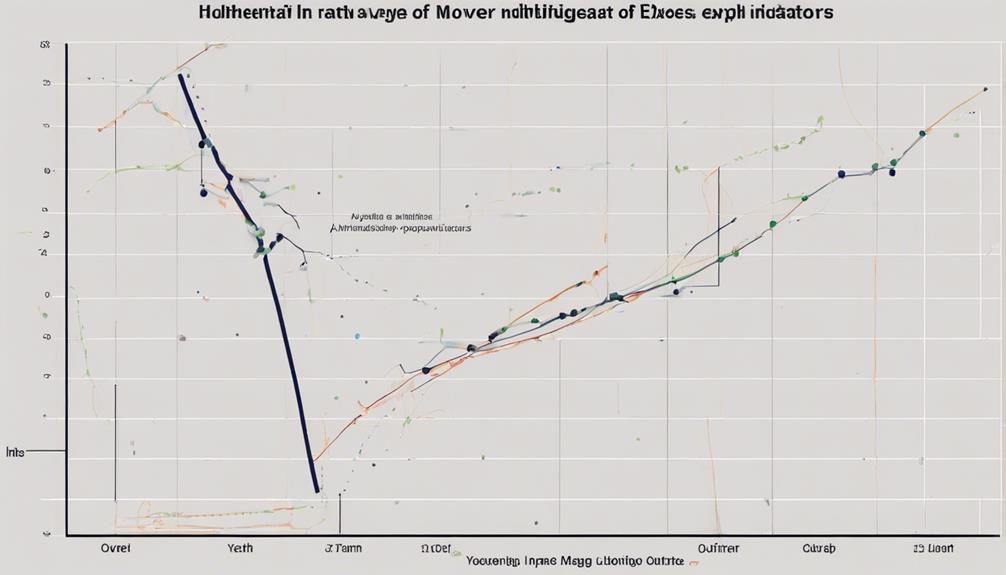
When utilizing EMA, consider the complexity of its calculation method, the inherent lagging nature of the indicator, and its sensitivity to price movements.
These factors can impact the accuracy and timeliness of signals generated by EMA.
Being aware of these limitations is crucial for effectively incorporating EMA into your trading strategies.
EMA Calculation Complexity
The complexity of EMA calculations lies in the intricate interplay between the smoothing factor, previous EMA values, and the multiplier that accentuates recent price movements.
- Interconnected Factors: The smoothing factor, previous EMA values, and the multiplier work together in EMA calculations.
- Weight on Recent Data: Increasing the smoothing factor emphasizes recent data over past values.
- Diverse Applications: EMA variations can utilize different price points such as open, high, low, or median prices, with common EMA lengths like 10-day, 50-day, and 200-day used for trend analysis.
EMA Lagging Indicator
Incorporating the nuances of EMA limitations and considerations reveals the intricacies of utilizing this lagging indicator in technical analysis. EMA, as an Exponential Moving Average, relies on historical data, making it a lagging indicator that may not accurately predict future prices.
Entry based on crossovers using EMA can be challenging due to delayed signals and market volatility, leading to false signals and whipsaw movements. To counter these limitations, it's advisable to confirm EMA signals with other indicators before making trade decisions.
EMA Sensitivity to Price
Considering EMA's heightened sensitivity to price changes compared to SMA, it's essential to acknowledge its potential impact on technical analysis outcomes.
The Exponential Moving Average reacts quickly to market fluctuations, making it susceptible to false signals and whipsaw movements, especially in volatile markets.
To navigate these challenges effectively, traders should combine EMA with other indicators to filter out noise and enhance accuracy.
By understanding EMA's limitations and considerations, traders can leverage its fast response to price movements to identify short-term trends and determine entry/exit points more efficiently.
Incorporating EMA into a comprehensive technical analysis strategy can provide valuable insights for making informed trading decisions.
Optimizing EMA for Trading Success
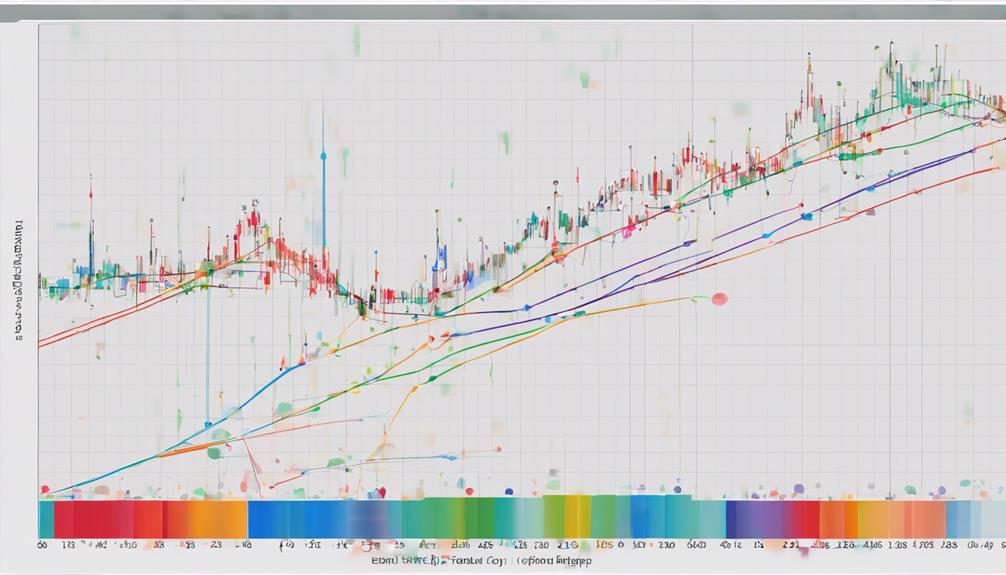
To optimize your trading success with Exponential Moving Averages (EMAs), consider adjusting the EMA periods based on market dynamics and combining them strategically with complementary indicators.
For short-term trading, optimal EMA periods like 9, 12, or 26 days are commonly used to capture fast-moving market trends efficiently. Enhance trade signal accuracy by incorporating technical indicators such as MACD or RSI alongside EMAs.
Adapting EMA parameters to market volatility can boost trading performance, with shorter EMAs proving effective in volatile conditions. Backtesting various EMA strategies on historical data is crucial in identifying the most profitable EMA settings for specific assets or markets.
Additionally, utilizing multiple EMAs with different periods, such as 9-day, 20-day, and 50-day, offers a comprehensive outlook on trend strength and potential reversals.
EMA Trends and Trend Identification
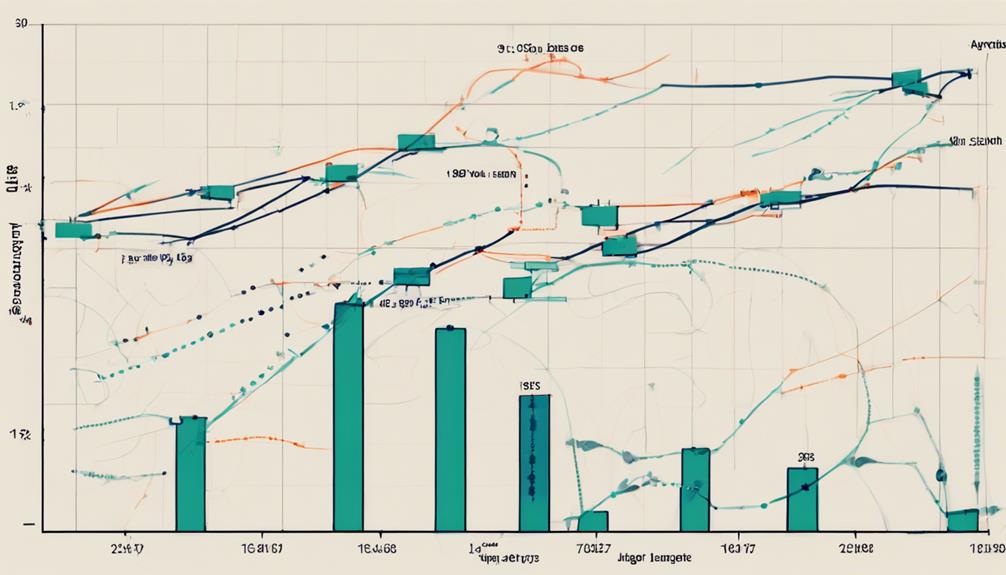
To effectively utilize EMA trends for trend identification, you must understand the significance of analyzing trend changes.
By pinpointing these shifts, you can make informed decisions on potential entry and exit points in the market.
Utilizing EMA crossovers and observing price movements can aid in detecting emerging trends early on.
Identifying EMA Trends
When identifying EMA trends in trading, observe the direction of the EMA line on a price chart to determine the market trend.
- Rising EMA: Indicates an uptrend.
- Falling EMA: Suggests a downtrend.
- Crosses: Between EMA lines can signal trend changes or potential trading opportunities.
Traders rely on EMA trends to confirm market direction and make well-informed trading decisions. By visualizing the strength and duration of price movements over time, EMA trends offer valuable insights into market dynamics. Keeping a close eye on EMA lines and their direction can help you stay ahead of trends and capitalize on trading opportunities with more confidence.
Analyzing Trend Changes
Analyzing trend changes with EMA trends and trend identification involves closely monitoring crossovers and trend strength to pinpoint potential buy or sell opportunities in trading. EMA, by emphasizing recent price data, aids in identifying trend changes effectively.
Traders rely on EMA crossovers as signals for adjusting trading strategies and capitalizing on market trends. The strength of a trend, as indicated by EMA, guides traders in determining the trend direction for informed decision-making.
EMA not only confirms existing market trends but also assists in spotting potential shifts, enabling traders to adapt promptly. By incorporating EMA into their analysis, traders can enhance their ability to identify buy opportunities during uptrends and sell opportunities during downtrends, optimizing their trading approach.
EMA Time Frames for Analysis
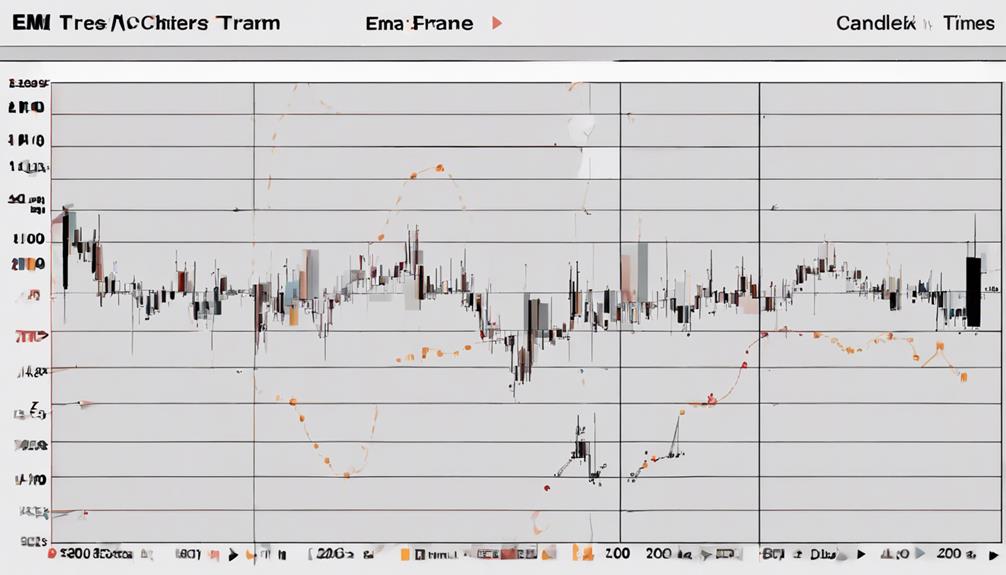
How do different EMA time frames influence trading strategies and analysis approaches? EMA time frames play a crucial role in determining the responsiveness of your analysis to market movements. Consider the following:
- Shorter EMA time frames like 5-day and 10-day are ideal for intraday trading strategies, providing quick insights into short-term price changes.
- Longer EMA periods such as 50-day and 200-day are suited for identifying and following long-term trends in the market.
- EMA time frames are chosen based on the desired sensitivity to price changes and the trading time horizon, helping traders adapt strategies to various market conditions efficiently.
EMA in Conjunction With Technical Indicators
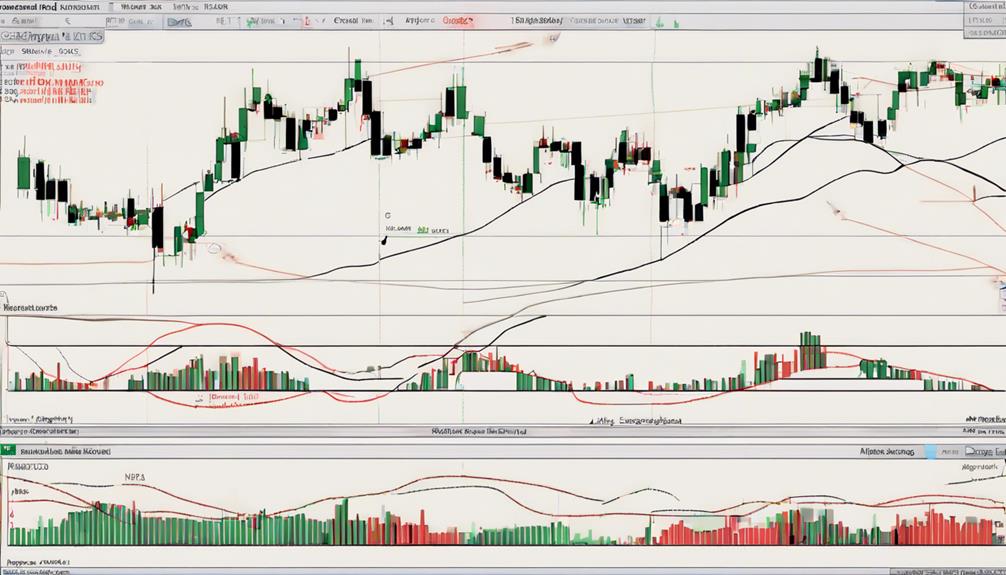
To extend the analysis of Exponential Moving Averages (EMAs) into their interaction with technical indicators, consider the ways in which EMAs can complement and enhance various trading signals.
EMA can be used alongside indicators like MACD and RSI to confirm buy/sell signals.
Combining EMA with Bollinger Bands aids in identifying potential price breakouts or breakdowns.
Utilizing EMA with Fibonacci retracement levels enhances support and resistance analysis for precise trade entries.
EMA crossovers with the Stochastic Oscillator can help determine overbought or oversold conditions, assisting traders in decision-making.
When paired with Volume indicators, EMA provides insights into the strength or weakness of a price trend, leading to improved trade accuracy.
How can I use Exponential Moving Averages in Practical Applications?
If you are looking for a practical moving averages application tutorial, consider implementing exponential moving averages in stock market analysis. By using EMA, you can identify market trends more effectively and make informed trading decisions. This practical approach can help improve your overall trading strategy.
Pros and Cons of EMA in Forecasting
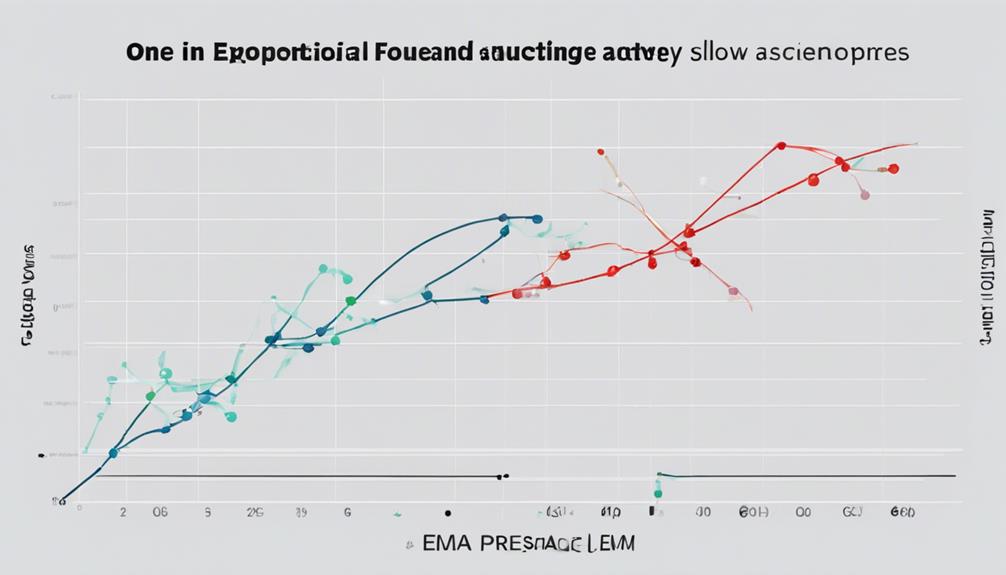
When utilizing Exponential Moving Averages (EMAs) for forecasting, traders must consider the benefits and limitations of this tool.
- Pros:
- EMA reacts faster to price changes, aiding in identifying short-term trends.
- Helps determine potential entry and exit points for trades.
- Provides dynamic support and resistance levels.
- Cons:
- Due to its emphasis on recent data, EMA may be more prone to whipsaws in volatile markets.
- It mightn't be as effective in capturing long-term trends compared to other moving averages.
- Over-reliance on EMA alone without considering other indicators could lead to inaccurate forecasts.
Considering these aspects can help traders make informed decisions when incorporating EMA into their forecasting strategies.
How can I apply exponential moving averages in practical situations using your explanations?
If you’re looking for a practical moving averages application guide, consider utilizing exponential moving averages to analyze stock price trends. By using recent data and assigning more weight to the most recent prices, exponential moving averages can provide a clearer picture of market momentum and potential entry or exit points for traders.
Frequently Asked Questions
How Do You Interpret Exponential Moving Averages?
To interpret exponential moving averages, you focus on trend direction. Buy near a rising EMA, sell near a falling one. EMAs can act as support or resistance. They offer trend insights but not precise entry/exit points. The smoothing constant determines recent price weight.
What Are the Best Exponential Moving Averages?
When choosing exponential moving averages, consider using common lengths like 10-day, 50-day, or 200-day EMAs. These lengths are popular for capturing various trends. Remember, the best EMA for you depends on your trading strategy and timeframe.
What Is the 5 8 13 21 EMA Strategy?
The 5 8 13 21 EMA strategy involves utilizing exponential moving averages with periods of 5, 8, 13, and 21 days to capture short and medium-term trends. It helps traders pinpoint potential market entry and exit points efficiently.
What Is the 5 EMA 10 EMA Strategy?
When trading with the 5 EMA 10 EMA strategy, watch for the crossroads of the 5-period and 10-period Exponential Moving Averages. A crossover where the 5 EMA moves above the 10 EMA suggests a buy, while the reverse indicates a sell.
Conclusion
You now possess the ultimate key to unlocking the mysteries of market trends and making informed trading decisions – the exponential moving average.
With its unparalleled sensitivity to price movements and ability to forecast future trends, EMA is your secret weapon for navigating the complex world of trading.
Embrace the power of EMA and watch your profits soar to new heights. It's not just a tool, it's a game-changer.
